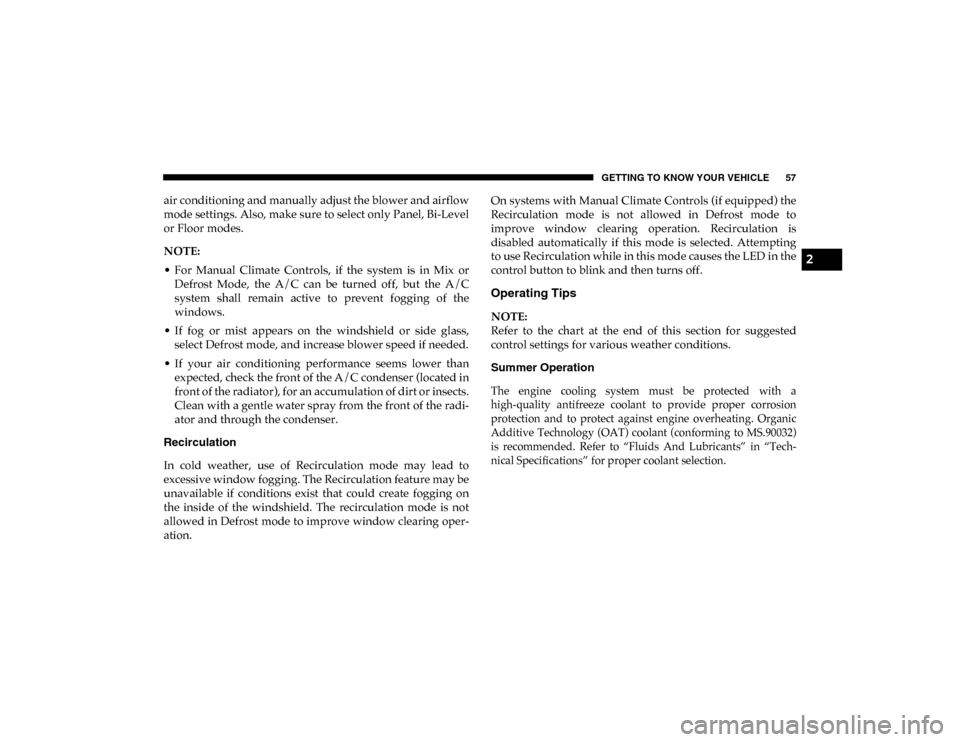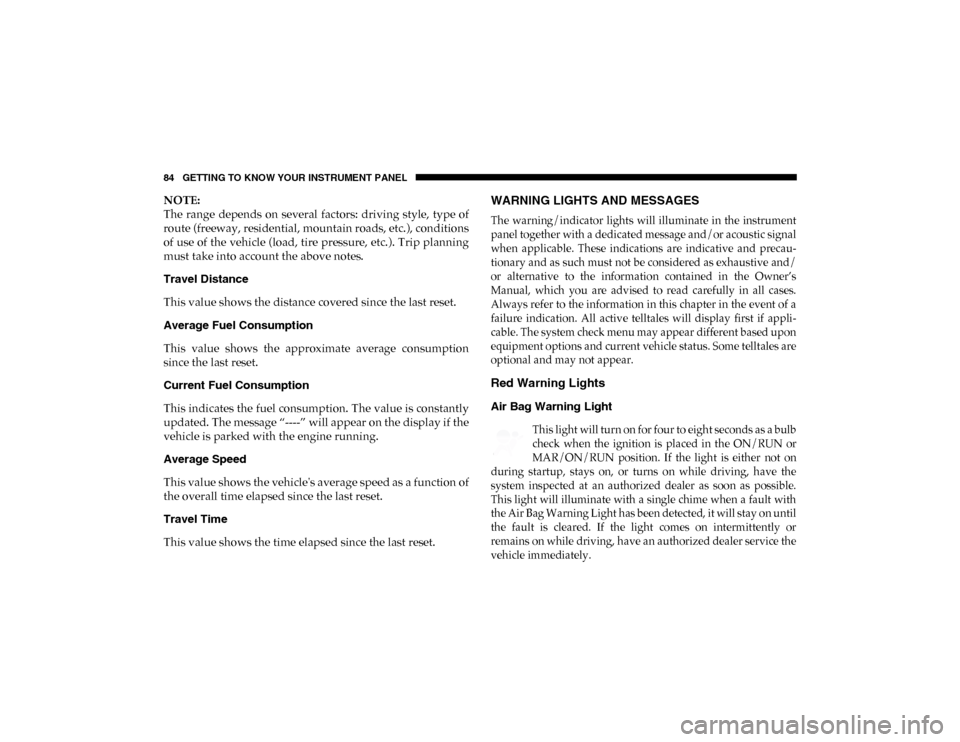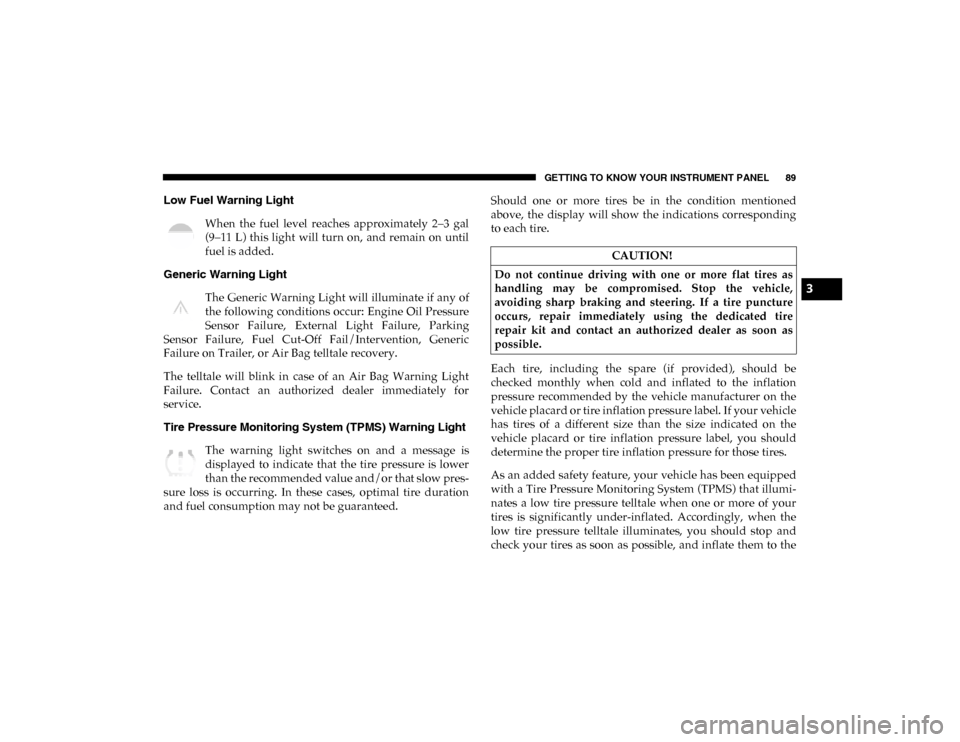check engine Ram ProMaster City 2020 Owner's Manual
[x] Cancel search | Manufacturer: RAM, Model Year: 2020, Model line: ProMaster City, Model: Ram ProMaster City 2020Pages: 350, PDF Size: 13.27 MB
Page 2 of 350

INSTALLATION OF RADIO TRANSMITTING
EQUIPMENT
Special design considerations are incorporated into this
vehicle’s electronic system to provide immunity to radio
frequency signals. Mobile two-way radios and telephone
equipment must be installed properly by trained person-
nel. The following must be observed during installation.
The positive power connection should be made
directly to the battery and fused as close to the battery as
possible. The negative power connection should be made
to body sheet metal adjacent to the negative battery
connection. This connection should not be fused.
Antennas for two-way radios should be mounted on
the roof or the rear area of the vehicle. Care should be
used in mounting antennas with magnet bases. Magnets
may affect the accuracy or operation of the compass on
vehicles so equipped.
The antenna cable should be as short as practical and
routed away from the vehicle wiring when possible. Use
only fully shielded coaxial cable.
Carefully match the antenna and cable to the radio to
ensure a low Standing Wave Ratio (SWR). Mobile radio equipment with output power greater than
normal may require special precautions.
All installations should be checked for possible
interference between the communications equipment
and the vehicle’s electronic systems.
Operating, servicing and maintaining a
passenger vehicle or off-highway motor
vehicle can expose you to chemicals inclu -
ding engine exhaust, carbon monoxide,
phthalates, and lead, which are known to
the State of California to cause cancer and
birth defects or other reproductive harm.
To minimize exposure, avoid breathing
exhaust, do not idle the engine except as ne -
cessary, service your vehicle in a well-ven -
tilated area and wear gloves or wash
your hands frequently when servicing
your vehicle. For more information go to
www.P65Warnings.ca.gov/passenger-vehicle.
WARNING:
VEHICLES SOLD IN CANADA
With respect to any vehicles sold in Canada, the name
FCA US LLC shall be deemed to be deleted and the
name FCA Canada Inc. used in substitution therefore.
DRIVING AND ALCOHOL
Drunken driving is one of the most frequent causes of
accidents.
Your driving ability can be seriously impaired with
blood alcohol levels far below the legal minimum. If
you are drinking, don’t drive. Ride with a designated
non-drinking driver, call a cab, a friend, or use public
transportation. This manual illustrates and describes the operation
of features and equipment that are either standard or
optional on this vehicle. This manual may also include
a description of features and equipment that are no
longer available or were not ordered on this vehicle.
Please disregard any features and equipment described
in this manual that are not on this vehicle.
FCA US LLC reserves the right to make changes in
design and specifications, and/or make additions to
or improvements to its products without imposing
any obligation upon itself to install them on products
previously manufactured.
Driving after drinking can lead to an accident.
Your perceptions are less sharp, your reflexes are
slower, and your judgment is impaired when you
have been drinking. Never drink and then drive.
WARNING!
Copyright © 2019 FCA US LLC
Page 3 of 350

INSTALLATION OF RADIO TRANSMITTING
EQUIPMENT
Special design considerations are incorporated into this
vehicle’s electronic system to provide immunity to radio
frequency signals. Mobile two-way radios and telephone
equipment must be installed properly by trained person-
nel. The following must be observed during installation.
The positive power connection should be made
directly to the battery and fused as close to the battery as
possible. The negative power connection should be made
to body sheet metal adjacent to the negative battery
connection. This connection should not be fused.
Antennas for two-way radios should be mounted on
the roof or the rear area of the vehicle. Care should be
used in mounting antennas with magnet bases. Magnets
may affect the accuracy or operation of the compass on
vehicles so equipped.
The antenna cable should be as short as practical and
routed away from the vehicle wiring when possible. Use
only fully shielded coaxial cable.
Carefully match the antenna and cable to the radio to
ensure a low Standing Wave Ratio (SWR). Mobile radio equipment with output power greater than
normal may require special precautions.
All installations should be checked for possible
interference between the communications equipment
and the vehicle’s electronic systems.
Operating, servicing and maintaining a
passenger vehicle or off-highway motor
vehicle can expose you to chemicals inclu -
ding engine exhaust, carbon monoxide,
phthalates, and lead, which are known to
the State of California to cause cancer and
birth defects or other reproductive harm.
To minimize exposure, avoid breathing
exhaust, do not idle the engine except as ne -
cessary, service your vehicle in a well-ven -
tilated area and wear gloves or wash
your hands frequently when servicing
your vehicle. For more information go to
www.P65Warnings.ca.gov/passenger-vehicle.
WARNING:
VEHICLES SOLD IN CANADA
With respect to any vehicles sold in Canada, the name
FCA US LLC shall be deemed to be deleted and the
name FCA Canada Inc. used in substitution therefore.
DRIVING AND ALCOHOL
Drunken driving is one of the most frequent causes of
accidents.
Your driving ability can be seriously impaired with
blood alcohol levels far below the legal minimum. If
you are drinking, don’t drive. Ride with a designated
non-drinking driver, call a cab, a friend, or use public
transportation. This manual illustrates and describes the operation
of features and equipment that are either standard or
optional on this vehicle. This manual may also include
a description of features and equipment that are no
longer available or were not ordered on this vehicle.
Please disregard any features and equipment described
in this manual that are not on this vehicle.
FCA US LLC reserves the right to make changes in
design and specifications, and/or make additions to
or improvements to its products without imposing
any obligation upon itself to install them on products
previously manufactured.
Driving after drinking can lead to an accident.
Your perceptions are less sharp, your reflexes are
slower, and your judgment is impaired when you
have been drinking. Never drink and then drive.
WARNING!
Copyright © 2019 FCA US LLC
Page 7 of 350

4
WARNING LIGHTS AND MESSAGES .......................... 84
Red Warning Lights ...................................................... 84
Yellow Warning Lights................................................. 88
Green Indicator Lights .................................................. 92
Blue Indicator Lights ..................................................... 93
ONBOARD DIAGNOSTIC SYSTEM — OBD II ............. 94
Onboard Diagnostic System (OBD II)
Cybersecurity ................................................................. 94
EMISSIONS INSPECTION AND MAINTENANCE
PROGRAMS ....................................................................... 95
SAFETY
SAFETY FEATURES ........................................................... 97
Four-Wheel Anti-Lock Brake System (ABS) ............ 97
Electronic Brake Control (EBC) System .................... 98
AUXILIARY DRIVING SYSTEMS .................................. 103
Tire Pressure Monitoring System (TPMS) ............. 103
OCCUPANT RESTRAINT SYSTEMS ........................... 108
Occupant Restraint Systems ...................................... 108
Important Safety Precautions .................................... 108
Seat Belt Systems ........................................................ 109
Supplemental Restraint Systems (SRS) .................... 120
Child Restraints ......................................................... 133
Transporting Pets ..................................................... 153
SAFETY TIPS ...................................................................153
Transporting Passengers ............................................153
Exhaust Gas ..............................................................153
Safety Checks You Should Make Inside
The Vehicle ..................................................................154
Periodic Safety Checks You Should Make Outside
The Vehicle ...................................................................156
STARTING AND OPERATING
STARTING THE ENGINE ..............................................157
Automatic Transmission.............................................157
Normal Starting ........................................................... 157
Cold Weather Operation ...........................................158
Extended Park Starting ...............................................158
If Engine Fails To Start ..............................................158
After Starting ................................................................159
ENGINE BLOCK HEATER — IF EQUIPPED .............159
ENGINE BREAK-IN RECOMMENDATIONS ............160
PARKING BRAKE ........................................................... 161
AUTOMATIC TRANSMISSION ....................................163
Key Ignition Park Interlock ........................................164
Brake/Transmission Shift Interlock System ............164
Nine-Speed Automatic Transmission ......................164
2020_RAM_PROMASTER_CITY_OM_USA=GUID-7B6A7FCA-79B0-423F-95C5-ED2A949C3D13=1=en=.book Page 4
Page 9 of 350

6
DRIVING TIPS................................................................... 196
Driving On Slippery Surfaces ................................... 196
Driving Through Water ............................................. 197
IN CASE OF EMERGENCY
HAZARD WARNING FLASHERS .............................. 199
BULB REPLACEMENT .................................................. 200
Replacement Bulbs ................................................... 200
Replacing Exterior Bulbs ............................................ 201
Replacing Interior Bulbs ............................................. 203
FUSES.................................................................................. 206
Underhood Fuses......................................................... 206
Interior Fuses................................................................ 209
Central Unit Fuse Panel .............................................. 211
JACKING AND TIRE CHANGING ............................... 212
Jack Location — If Equipped ..................................... 212
Removing The Spare Tire — If Equipped ................ 213
Preparations For Jacking ........................................... 217
Jacking Instructions ..................................................... 218
Vehicles With Alloy Wheels ...................................... 224
Vehicles Equipped With Wheel Covers ................... 226
TIRE SERVICE KIT — IF EQUIPPED ........................... 227
Tire Service Kit Storage .............................................. 227
Tire Service Kit Usage ................................................. 227
JUMP STARTING..............................................................231
Preparations For Jump Starting ................................. 231
Jump Starting Procedure ............................................232
IF YOUR ENGINE OVERHEATS ..................................234
IGNITION KEY REMOVAL OVERRIDE ......................235
GEAR SELECTOR OVERRIDE .....................................236
FREEING A STUCK VEHICLE ......................................237
TOWING A DISABLED VEHICLE ...............................238
ENHANCED ACCIDENT RESPONSE
SYSTEM (EARS) ...............................................................240
EVENT DATA RECORDER (EDR)................................. 240
SERVICING AND MAINTENANCE
SCHEDULED SERVICING .............................................241
Maintenance Plan ........................................................242
ENGINE COMPARTMENT .......................................... 245
Engine Compartment — 2.4L ....................................245
Checking Oil Level ......................................................246
Adding Washer Fluid .................................................246
Maintenance-Free Battery .......................................... 247
Pressure Washing ........................................................248
2020_RAM_PROMASTER_CITY_OM_USA=GUID-7B6A7FCA-79B0-423F-95C5-ED2A949C3D13=1=en=.book Page 6
Page 60 of 350

GETTING TO KNOW YOUR VEHICLE 57
air conditioning and manually adjust the blower and airflow
mode settings. Also, make sure to select only Panel, Bi-Level
or Floor modes.
NOTE:
• For Manual Climate Controls, if the system is in Mix orDefrost Mode, the A/C can be turned off, but the A/C
system shall remain active to prevent fogging of the
windows.
• If fog or mist appears on the windshield or side glass, select Defrost mode, and increase blower speed if needed.
• If your air conditioning performance seems lower than expected, check the front of the A/C condenser (located in
front of the radiator), for an accumulation of dirt or insects.
Clean with a gentle water spray from the front of the radi -
ator and through the condenser.
Recirculation
In cold weather, use of Recirculation mode may lead to
excessive window fogging. The Recirculation feature may be
unavailable if conditions exist that could create fogging on
the inside of the windshield. The recirculation mode is not
allowed in Defrost mode to improve window clearing oper -
ation. On systems with Manual Climate Controls (if equipped) the
Recirculation mode is not allowed in Defrost mode to
improve window clearing operation. Recirculation is
disabled automatically if this mode is selected. Attempting
to use Recirculation while in this mode causes the LED in the
control button to blink and then turns off.
Operating Tips
NOTE:
Refer to the chart at the end of this section for suggested
control settings for various weather conditions.
Summer Operation
The engine cooling system must be protected with a
high-quality antifreeze coolant to provide proper corrosion
protection and to protect against engine overheating. Organic
Additive Technology (OAT) coolant (conforming to MS.90032)
is recommended. Refer to “Fluids And Lubricants” in “Tech
-
nical Specifications” for proper coolant selection.
2
2020_RAM_PROMASTER_CITY_OM_USA=GUID-7B6A7FCA-79B0-423F-95C5-ED2A949C3D13=1=en=.book Page 57
Page 87 of 350

84 GETTING TO KNOW YOUR INSTRUMENT PANEL
NOTE:
The range depends on several factors: driving style, type of
route (freeway, residential, mountain roads, etc.), conditions
of use of the vehicle (load, tire pressure, etc.). Trip planning
must take into account the above notes.
Travel Distance
This value shows the distance covered since the last reset.
Average Fuel Consumption
This value shows the approximate average consumption
since the last reset.
Current Fuel Consumption
This indicates the fuel consumption. The value is constantly
updated. The message “----” will appear on the display if the
vehicle is parked with the engine running.
Average Speed
This value shows the vehicle's average speed as a function of
the overall time elapsed since the last reset.
Travel Time
This value shows the time elapsed since the last reset.WARNING LIGHTS AND MESSAGES
The warning/indicator lights will illuminate in the instrument
panel together with a dedicated message and/or acoustic signal
when applicable. These indications are indicative and precau-
tionary and as such must not be considered as exhaustive and/
or alternative to the information contained in the Owner’s
Manual, which you are advised to read carefully in all cases.
Always refer to the information in this chapter in the event of a
failure indication. All active telltales will display first if appli -
cable. The system check menu may appear different based upon
equipment options and current vehicle status. Some telltales are
optional and may not appear.
Red Warning Lights
Air Bag Warning Light
This light will turn on for four to eight seconds as a bulb
check when the ignition is placed in the ON/RUN or
MAR/ON/RUN position. If the light is either not on
during startup, stays on, or turns on while driving, have the
system inspected at an authorized dealer as soon as possible.
This light will illuminate with a single chime when a fault with
the Air Bag Warning Light has been detected, it will stay on until
the fault is cleared. If the light comes on intermittently or
remains on while driving, have an authorized dealer service the
vehicle immediately.
2020_RAM_PROMASTER_CITY_OM_USA=GUID-7B6A7FCA-79B0-423F-95C5-ED2A949C3D13=1=en=.book Page 84
Page 89 of 350

86 GETTING TO KNOW YOUR INSTRUMENT PANEL
Operation of the Brake Warning Light can be checked by turning
the ignition switch from the OFF position to the ON/RUN posi-
tion. The light should illuminate for approximately two seconds.
The light should then turn off unless the parking brake is applied
or a brake fault is detected. If the light does not illuminate, have
the light inspected by an authorized dealer.
The light also will turn on when the parking brake is applied
with the ignition switch in the ON/RUN position.
NOTE:
This light shows only that the parking brake is applied. It
does not show the degree of brake application.
Battery Charge Warning Light
This warning light will illuminate when the battery
is not charging properly. If it stays on while the
engine is running, there may be a malfunction with
the charging system. Contact an authorized dealer as soon as
possible.
This indicates a possible problem with the electrical system
or a related component. Door Open Warning Light
This indicator will illuminate when one or more
door(s) are not fully closed.
NOTE:
If the vehicle is moving and a door is opened, there will also
be a single chime.
Electronic Throttle Control (ETC) Warning Light This warning light will illuminate to inform of a
problem with the Electronic Throttle Control (ETC)
system. If a problem is detected while the vehicle is
running, the light will either stay on or flash depending on
the nature of the problem. Cycle the ignition when the
vehicle is safely and completely stopped and the transmis -
sion is placed in the PARK (P) position. The light should turn
off. If the light remains on with the vehicle running, your
vehicle will usually be drivable; however, see an authorized
dealer for service as soon as possible.
2020_RAM_PROMASTER_CITY_OM_USA=GUID-7B6A7FCA-79B0-423F-95C5-ED2A949C3D13=1=en=.book Page 86
Page 90 of 350

GETTING TO KNOW YOUR INSTRUMENT PANEL 87
If the light continues to flash when the vehicle is running,
immediate service is required and you may experience
reduced performance, an elevated/rough idle, or engine
stall and your vehicle may require towing. The light will
come on when the ignition is placed in the ON/RUN or
MAR/ON/RUN position and remain on briefly as a bulb
check. If the light does not come on during starting, have the
system checked by an authorized dealer.
Engine Coolant Temperature Warning Light This warning light warns of an overheated engine
condition. If the engine coolant temperature is too
high, this indicator will illuminate and a single
chime will sound. If the temperature reaches the upper limit,
a continuous chime will sound for four minutes or until the
engine is able to cool, whichever comes first.
If the light turns on while driving, safely pull over and stop
the vehicle. If the A/C system is on, turn it off. Also, shift the
transmission into NEUTRAL (N) and idle the vehicle. If the
temperature reading does not return to normal, turn the
engine off immediately and call for service.
Refer to “If Your Engine Overheats” in “In Case Of Emer -
gency” for further information. Oil Pressure Warning Light
This warning light will illuminate to indicate low
engine oil pressure. If the light turns on while
driving, stop the vehicle, shut off the engine as soon
as possible, and contact an authorized dealer. A chime will
sound when this light turns on.
Do not operate the vehicle until the cause is corrected. This
light does not indicate how much oil is in the engine. The
engine oil level must be checked under the hood.
Transmission Temperature Warning Light — If Equipped
This warning light will illuminate to warn of a high
transmission fluid temperature. This may occur with
strenuous usage such as trailer towing. If this light
turns on, stop the vehicle and run the engine at idle or
slightly faster, with the transmission in PARK (P) or
NEUTRAL (N), until the light turns off. Once the light turns
off, you may continue to drive normally.
WARNING!
If you continue operating the vehicle when the
Transmission Temperature Warning Light is illuminated
you could cause the fluid to boil over, come in contact
with hot engine or exhaust components and cause a fire.
3
2020_RAM_PROMASTER_CITY_OM_USA=GUID-7B6A7FCA-79B0-423F-95C5-ED2A949C3D13=1=en=.book Page 87
Page 92 of 350

GETTING TO KNOW YOUR INSTRUMENT PANEL 89
Low Fuel Warning LightWhen the fuel level reaches approximately 2–3 gal
(9–11 L) this light will turn on, and remain on until
fuel is added.
Generic Warning Light The Generic Warning Light will illuminate if any of
the following conditions occur: Engine Oil Pressure
Sensor Failure, External Light Failure, Parking
Sensor Failure, Fuel Cut-Off Fail/Intervention, Generic
Failure on Trailer, or Air Bag telltale recovery.
The telltale will blink in case of an Air Bag Warning Light
Failure. Contact an authorized dealer immediately for
service.
Tire Pressure Monitoring System (TPMS) Warning Light
The warning light switches on and a message is
displayed to indicate that the tire pressure is lower
than the recommended value and/or that slow pres -
sure loss is occurring. In these cases, optimal tire duration
and fuel consumption may not be guaranteed. Should one or more tires be in the condition mentioned
above, the display will show the indications corresponding
to each tire.
Each tire, including the spare (if provided), should be
checked monthly when cold and inflated to the inflation
pressure recommended by the vehicle manufacturer on the
vehicle placard or tire inflation pressure label. If your vehicle
has tires of a different size than the size indicated on the
vehicle placard or tire inflation pressure label, you should
determine the proper tire inflation pressure for those tires.
As an added safety feature, your vehicle has been equipped
with a Tire Pressure Monitoring System (TPMS) that illumi
-
nates a low tire pressure telltale when one or more of your
tires is significantly under-inflated. Accordingly, when the
low tire pressure telltale illuminates, you should stop and
check your tires as soon as possible, and inflate them to the
CAUTION!
Do not continue driving with one or more flat tires as
handling may be compromised. Stop the vehicle,
avoiding sharp braking and steering. If a tire puncture
occurs, repair immediately using the dedicated tire
repair kit and contact an authorized dealer as soon as
possible.
3
2020_RAM_PROMASTER_CITY_OM_USA=GUID-7B6A7FCA-79B0-423F-95C5-ED2A949C3D13=1=en=.book Page 89
Page 94 of 350

GETTING TO KNOW YOUR INSTRUMENT PANEL 91
Engine Check/Malfunction Indicator Warning Light (MIL)
The Engine Check/Malfunction Indicator Light
(MIL) is a part of an Onboard Diagnostic System
called OBD II that monitors engine and automatic
transmission control systems. This warning light will illu -
minate when the ignition is in the ON/RUN position before
engine start. After placing the ignition to the ON/RUN
position, if there is a problem with the Sentry Key System,
the Vehicle Security Light will turn on. This condition will
result in the engine being shut off after two seconds. If the
bulb does not come on when turning the ignition switch
from OFF to ON/RUN, have the condition checked
promptly.
NOTE:
This warning light will illuminate when the vehicle security
alarm system has detected an attempt to break into the
vehicle.
Certain conditions, such as a loose or missing gas cap, poor
quality fuel, etc., may illuminate the light after engine start.
The vehicle should be serviced if the light stays on through
several typical driving styles. In most situations, the vehicle
will drive normally and will not require towing. When the engine is running, the MIL may flash to alert
serious conditions that could lead to immediate loss of
power or severe catalytic converter damage. The vehicle
should be serviced by an authorized dealer as soon as
possible if this occurs.
WARNING!
A malfunctioning catalytic converter, as referenced
above, can reach higher temperatures than in normal
operating conditions. This can cause a fire if you drive
slowly or park over flammable substances such as dry
plants, wood, cardboard, etc. This could result in death
or serious injury to the driver, occupants or others.
CAUTION!
Prolonged driving with the Malfunction Indicator Light
(MIL) on could cause damage to the vehicle control
system. It also could affect fuel economy and
driveability. If the MIL is flashing, severe catalytic
converter damage and power loss will soon occur.
Immediate service is required.3
2020_RAM_PROMASTER_CITY_OM_USA=GUID-7B6A7FCA-79B0-423F-95C5-ED2A949C3D13=1=en=.book Page 91